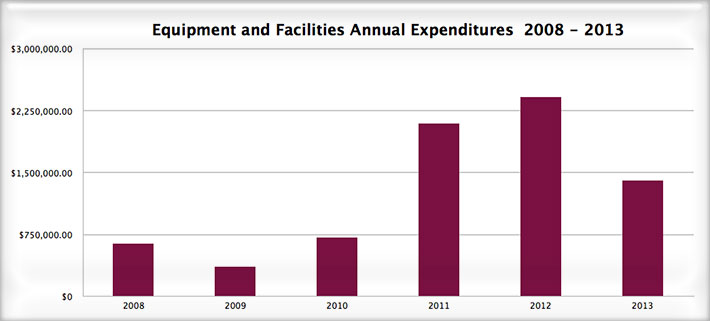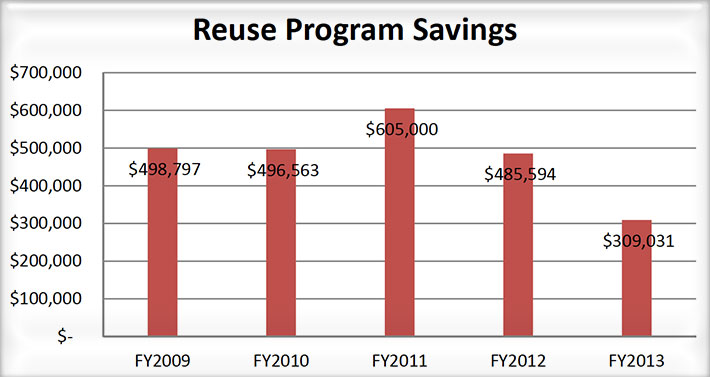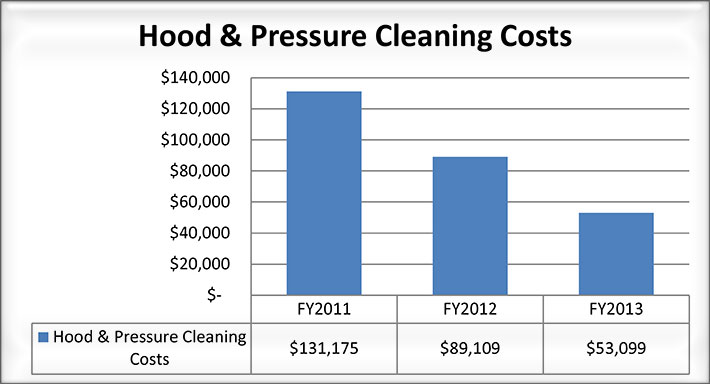

Equipment & Facilities Team 5 Year Summary of Program
Over the past five years the successful programs developed and piloted by the Equipment Team in 2002 have been refined and incorporated into everyday practice. The demand for efficient products fit right into the Districts direction of adapting to the LEED certified Building Program along with the adoption of the utilization of toxic free chemicals for cleaning. The intent of this summary is to present an overview of the efficiencies developed by the School Food Service Equipment & Facilities Team over the last five fiscal years; 2008 through the end of fiscal year 2013. This will reflect the practices and philosophies adopted as standard, as well as the direction we are heading to continue to build efficiencies.

Equipment Reuse:
Over the past five years the reuse of equipment, as opposed to purchasing new equipment, has resulted in a $450,000 cost savings. In 2008 the reuse of equipment from sites being modernized had reached its peak. As new school construction began to slow, so did the availability of equipment to be reused. In order to ensure the longevity of this equipment we developed and began a periodical maintenance program. The reuse of previously purchased replacement equipment from sites being modernized and the increase in purchasing new equipment since 2008 has decreased our average age of equipment from 15.5 years to its current average of 8.75 years.

Hood Cleaning/Pressure Washing:
In the later part of 2009, as part of budget assessments and program modifications, the service of annual hood cleaning and inspection along with pressure washing of floors was brought in house to allow more efficient use of time. Additionally this program reduced the cost of the service from $140,000 to $95,000 for the initial startup year to include the initial purchase of equipment. Subsequent years should show an expense of $75,000 for the same services; an annual cost savings of $65,000. This position also realized a cost savings and an increase in efficiencies as the technician also cleans some of the refrigeration coils in the kitchens. 
Expanding the Team:
In 2009 the School Food Service Administrative Team took a hard look at the current work order system and determined a change in direction was necessary. At that time the economy was on a down turn and the Facilities Services Department was being faced with budget cuts to include a reduction in staff. A Quality Assurance Maintenance Program was developed by School Food Service that would transfer four Facility Services employees from the Facilities Services budget to the School Food Service budget. School Food Service Administration worked closely with Facilities Services Administration, Support Operations and Chief Operating Officer to develop a comprehensive Responsibility Matrix to outline and define the responsibilities being split between the two departments.
We planned to address the program with a split of work load between in house staff and contract awarded vendors. The initial start would allow in house staff to visit each site for a Quality Assurance (QA) assessment with a defined and laid out process to go through clean up and evaluate each site with consistency. Vendors would be utilized to handle day to day emergencies and other work orders to allow in house staff to perform the Quality Assurance visits.
Phase 2 of the program would begin as the Quality Assurance visits were nearing completion. At this time the majority of work orders would be addressed by in house staff and the vendor repairs would be significantly reduced.
In July of 2010 we initiated the QA program. The three year plan called for the completion of QA visits by June 30, 2013. Through the first year of the QA implementation it became clear that a preventive maintenance plan would need to be developed to dovetail with the QAs. The work orders were increasing even with the outsourcing of repairs, requiring team members to reprioritize to assist with faulty equipment.
In July of 2011 we had not quite impacted a third of the facilities; however it was decided to schedule a preventive maintenance visit to each site to clean coils, change filters, and perform a variety of service to the various pieces of equipment in each kitchen. This plan would assist in the reduction of work orders related to failures from equipment not being properly maintained. The vendors were also utilized to reduce the amount of open work orders to 79 for the start of school in August 2011. The vendors continued to address work order concerns, in house technicians addressed Quality Assurance visits, and replacement equipment purchases were on the increase.
As a result of preventive maintenance performed in 2011, there was a noticeable decrease in refrigeration work orders submitted, therefore, preventive maintenance continued to be performed in the 2011-2012 school year and the 2012- 2013 school year.
The successful completion of the QA visits occurred on schedule in June 2013.
A planned maintenance program for additional equipment has been developed and will be implemented beginning in July of 2013. Manufacturer recommendations for the equipment, along with successful program reviews from large operations within the Food Service Industry, were utilized to develop the maintenance plan for the future. It was determined that the initial schedule will allow quarterly maintenance visitation of all sites once every thirteen weeks. This will allow for greater efficiencies in grouping of work orders, decrease vehicle mileage and fuel consumption, and time management.
Training:
Continuing education was a goal for existing, as well as the incoming staff from the Facilities Services Department. Team members attended parts of the School Food Service Manager Training to increase their capabilities and to help them understand the rules and guidelines included in the safe handling and preparation of food. All Equipment Team members are certified in ServSafe and CPR & AED in addition to other technical certifications and training they receive.
Work Orders:
School Food Service started to utilize the work order system being implemented in the Facilities Services Division. During the implementation of this new system it was realized it would not be able to distinguish budget differences between the two departments. This discovery meant that School Food Service would have to develop a work order system to track all aspects of the work orders and the costs of labor and materials associated with the completion of those work orders. This would also need to be expanded to cover deletion of equipment, truck stock, and warehouse inventory of commonly utilized items as well. A data entry list was created in the School Food Service Share Point Site to track all the needed information regarding the work orders.
Succession Training:
In April of 2013 we also started assessment of the future of operations within the team. We are reviewing eligibility for retirement and assessing career paths to look at successively training replacements for team members to support the longevity of not only this program, but for this department and its goals and success as well.
IMAGE 4
